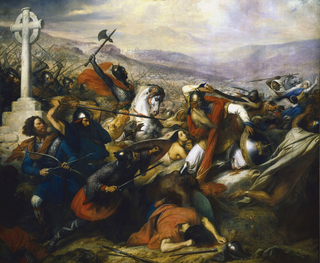
Louis the Pious, also called the Fair and the Debonaire, was King of the Franks and co-emperor with his father, Charlemagne, from 813. He was also King of Aquitaine from 781. As the only surviving son of Charlemagne and Hildegard, he became the sole ruler of the Franks after his father's death in 814, a position that he held until his death except from 833 to 834, when he was deposed.

Year 844 (DCCCXLIV) was a leap year starting on Tuesday of the Julian calendar.

Septimania is a historical region in modern-day Southern France. It referred to the western part of the Roman province of Gallia Narbonensis that passed to the control of the Visigoths in 462, when Septimania was ceded to their king, Theodoric II. During the Early Middle Ages, the region was variously known as Gallia Narbonensis, Gallia, or Narbonensis. The territory of Septimania roughly corresponds with the modern French former administrative region of Languedoc-Roussillon that merged into the new administrative region of Occitanie. In the Visigothic Kingdom, which became centred on Toledo by the end of the reign of Leovigild, Septimania was both an administrative province of the central royal government and an ecclesiastical province whose metropolitan was the Archbishop of Narbonne. Originally, the Goths may have maintained their hold on the Albigeois, but if so it was conquered by the time of Chilperic I. There is archaeological evidence that some enclaves of Visigothic population remained in Frankish Gaul, near the Septimanian border, after 507.

Francia, also called the Kingdom of the Franks, Frankish Kingdom, Frankland or Frankish Empire, was the largest post-Roman barbarian kingdom in Western Europe. It was ruled by the Frankish Merovingian and Carolingian dynasties during the Early Middle Ages. Francia was among the last surviving Germanic kingdoms from the Migration Period era.
Gaucelm was a Frankish count and leading magnate in Gothia during the reign of Louis the Pious. He was initially the Count of Roussillon from about 800, but he received Empúries in 817 and was thenceforward the chief representative of imperial authority in that region.
Rampon (Rampó) was the second count of the Catalan counties of Barcelona and Osona from 820 until his death in 825.
Bernardof Septimania (795–844), son of William of Gellone, who was the cousin of Charlemagne and was the Frankish Duke of Septimania and Count of Barcelona from 826 to 832 and again from 835 to his execution. He was also count of Carcassonne from 837. He was appointed to succeed his fellow Frank Rampon. During his career, he was one of the closest counsellors of the Emperor Louis the Pious, a leading proponent of the war against the Moors, and opponent of the interests of the local Visigothic nobility.

Honoratus was the founder of Lérins Abbey who later became an early Archbishop of Arles. He is honored as a saint in the Catholic and Eastern Orthodox Churches.

Pepin the Short, was King of the Franks from 751 until his death in 768. He was the first Carolingian to become king.
Sunifred was the Count of Barcelona as well as many other Catalan and Septimanian counties, including Ausona, Besalú, Girona, Narbonne, Agde, Béziers, Lodève, Melgueil, Cerdanya, Urgell, Conflent and Nîmes, from 834 to 848 and from 844 to 848 (others).

The County of Barcelona was a polity in northeastern Iberian Peninsula, originally located in the southern frontier region of the Carolingian Empire. In the 10th century, the Counts of Barcelona progressively achieved independence from Frankish rule, becoming hereditary rulers in constant warfare with the Islamic Caliphate of Córdoba and its successor states. The counts, through marriage, alliances and treaties, acquired or vassalized the other Catalan counties and extended their influence over Occitania. In 1164, the County of Barcelona entered a personal union with the Kingdom of Aragon. Thenceforward, the history of the county is subsumed within that of the Crown of Aragon, but the city of Barcelona remained preeminent within it.
The viscount of Narbonne was the secular ruler of Narbonne in the Middle Ages. Narbonne had been the capital of the Visigoth province of Septimania, until the 8th century, after which it became the Carolingian Viscounty of Narbonne. Narbonne was nominally subject to the Carolingian counts of Toulouse but was usually governed autonomously. The city was a major port on the Mediterranean Sea. In the 12th century, Ermengarde of Narbonne presided over one of the cultural centers where the spirit of courtly love was developed. In the 15th century Narbonne passed to the County of Foix and in 1507 to the royal domain of France.
William of Septimania was the son of Bernard and Dhuoda. He was the count of Toulouse from 844 and count of Barcelona from 848.
Guerin, Garin, Warin, or Werner was the Count of Auvergne, Chalon, Mâcon, Autun, Arles and Duke of Provence, Burgundy, and Toulouse. Guerin established the region against the Saracens from a base of Marseille and fortified Chalon-sur-Saône (834). He took part in many campaigns during the civil wars that marked the reign of Louis the Pious (814–840) and after his death until the Treaty of Verdun (843). The primary sources for his life are charters and chronicles like the Vita Hludovici.
Septimania was the western region of the Roman province of Gallia Narbonensis that passed under the control of the Visigoths in 462. It passed briefly to the Emirate of Córdoba in the eighth century before its reconquest by the Franks, who by the end of the ninth century termed it Gothia. This article presents a timeline of its history.
The County of Pallars or Pallás was a de facto independent petty state, nominally within the Carolingian Empire and then West Francia during the ninth and tenth centuries, perhaps one of the Catalan counties, originally part of the Marca Hispanica in the ninth century. It was coterminous with the upper Noguera Pallaresa valley from the crest of the Pyrenees to the village of Tremp, comprising the Vall d'Àneu, Vall de Cardós, Vall Ferrera, the right bank of the Noguera Ribagorçana, and the valley of the Flamicell. It roughly corresponded with the historic region of Catalonia called Pallars. Its chief city was Sort.

The County of Razès was a feudal jurisdiction in Occitania, south of the County of Carcassonne, in what is now Southern France. It was founded in 781, after the creation of the Kingdom of Aquitania, when Septimania was separated from that state.

The Umayyad invasion of Gaul occurred in two phases in 719 and 732 AD. Although the Umayyads secured control of Septimania, their incursions beyond this into the Loire and Rhône valleys failed. By 759 Muslim forces had lost Septimania to the Christian Franks and retreated to Iberia.

Boson II of Arles was Count of Avignon from 935 and Count of Arles from 949. Around 953, Boso II married Constance, possibly a daughter of the Bivinid Charles Constantine, Count of Vienne, from whom he got two sons: Rotbold II (Roubaud), and William I, Count of Arles and Provence, and then Margrave of Provence. His origin is controversial, even though his life is relatively well known.